Why has Latin in medieval Britain been neglected by scholars?
by Dr Richard Ashdowne
15 Jun 2018
Of the many languages in use in Britain in the middle ages, Latin is arguably the best attested and yet most overlooked. Even the fact that most of the famous medieval texts, such as the Domesday Book and Magna Carta, were written in Latin is little appreciated; yet it is remarkable, because these and all the other Latin works of the period were written by people for whom it was not a native language.
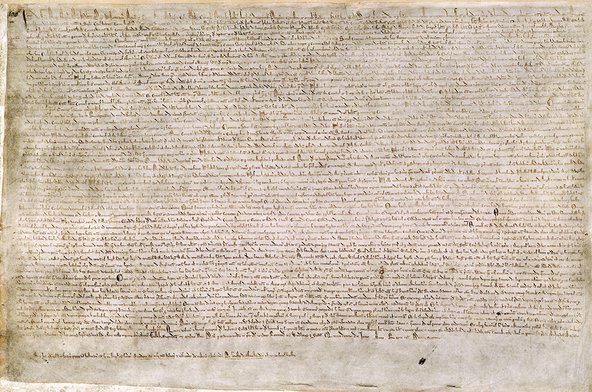
Magna Carta (originally known as the Charter of Liberties) of 1215 was written in medieval Latin. Image credit: British Library via Wikimedia Commons.
After the departure of the Roman legions from Britain, the continued use of Latin was by no means assured, but in fact it was used right up to the time of the Tudors and beyond. For more than a thousand years, the people of Britain used Latin not merely in ponderous works of church and state – as is often portrayed – but in a wide variety of genres for all manner of functions, from accountancy to zoology.
But despite its indisputable importance for the people of Britain and their societies, and despite so much of it having survived, medieval Latin in Britain has received very little attention. It is worth considering why.
The main issues
The chief problem seems to be that, because it’s in Latin, the vast quantity of material that does exist is only accessible to those who have had a strong training in the language itself, with only a small proportion available in translation. However, because of the way Latin is usually taught both in schools and universities, most training comes from studying Latin from its native era. i.e. the language of the Romans – specifically the high-register literary ‘classical’ variety.
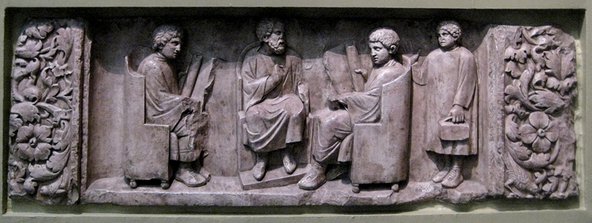
A relief of a Roman teacher with three discipuli. Image credit: Wikipedia / Shakko.
Moreover, along with such a training in Latin there seems invariably to come a view (largely deriving from late Roman grammarians and reinforced by the Renaissance) that only the classical Latin of the texts that have survived from the period of the late Roman republic and early Empire is ‘good’ Latin: anything that differs from this standard is considered inferior and worthy of little if any attention. Therefore, medieval Latin, which in its huge variety does often differ from this narrow standard, is often dismissed by classicists, whether they have actually read any medieval Latin or not.
A final problem is that because medieval Latin is seen primarily as the language of the Christian church during the period, traditional classicists often believe that the subject matter would only prove to be irrelevant or tiresome.
The quality of medieval Latin writing
Let’s turn first to the classicist’s notion of the poor quality of medieval Latin. Whether quality here refers to adherence to certain grammatical rules or the achievement of elegant style, in fact medieval writers were neither universally nor even typically deficient. Certainly not every writer wrote prose like Cicero and Caesar nor verse like Virgil and Ovid, any more than all the Romans had done, even other admired Roman literary figures. However, many in the middle ages did write impressively literary works using essentially the variety of Latin given prestige by these authors. This is particularly evident in the works of many medieval historians, such as the Venerable Bede, William of Malmesbury, and Matthew Paris, as well as satirists, such as Walter Map, and others.
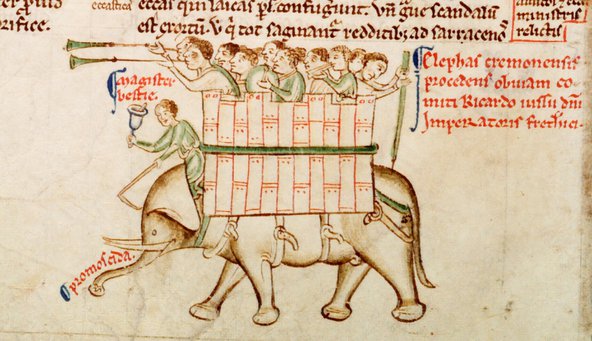
Elephant by Matthew Paris from Parker MS 16, fol 151v
Indeed, medieval authors’ use of allusion and quotation in their works often also reveals a remarkable level of familiarity with classical authors’ writings, as well as their own original literary achievements. For instance, Neil Wright has shown this in the works of William of Malmesbury and Joseph of Exeter. William of Malmesbury makes effective use of allusions to Virgil, Juvenal and Suetonius in his historical narrative, in some places implicitly drawing comparisons between William Rufus and several of Suetonius’ emperor subjects. Meanwhile, the 12th-century poet Joseph of Exeter, in his Bellum Trojanum, can be seen to follow the finer points of versification observed by Virgil and Ovid and is writing about a thoroughly epic theme, the Trojan War; he alludes stylistically not only to Virgil and Ovid but also to Lucan and Statius among others.
Yet neither William in prose nor Joseph in verse were merely stitching together some kind of anachronistic patchwork of ancient snippets as unimaginative derivatives of their ancient influences. They are their own authors, with their own narratives, ideas and purposes. Joseph’s description of Helen brings in contemporary medieval understanding of the body, its organs, and their relationship to character and emotion: her heart, lungs and spleen are not the problem; it is her liver that drives her on to ruin.
We see evidence of the medieval writers’ wide reading and understanding of earlier Latin in less obvious places too: the medieval Latin writings contain many unusual classical Latin words, particularly in the glossaries and word-lists of the period.
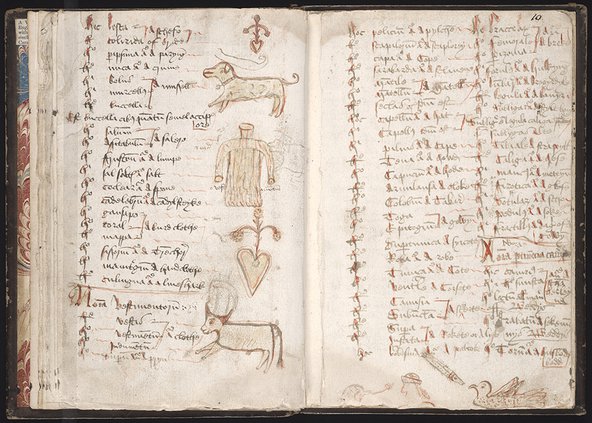
A 15th century manuscript of Latin-English vocabulary. Image credit: Beinecke Rare Book & Manuscript Library.
Medieval writers further demonstrate their confidence in Latin in the way they supply new vocabulary to fill gaps where new inventions or ideas were not covered by the inherited classical language. Just as the Romans had, they add new meanings to existing words, create new derivatives, or simply borrow from their native languages.
In content, style, grammar and vocabulary, many were highly accomplished users of the language in a variety we can recognise as ‘classical’. Many wrote no less impressively eloquent and effective works using the Latin language as it had become by their own day, a variety that they also employed for many other purposes, from religion and law to science and accounting.
Moreover, even though some medieval Latin is not fully classical, the classicist cannot blithely ignore the potential effect of all the medieval use of Latin on the classical texts of the Roman era. This influence may sound back to front. However, those classical texts themselves survive into the modern world because of a manuscript tradition (i.e. copies made from earlier copies made from earlier copies etc.) in which medieval readers and writers participated. A chain of copying inevitably leads to the intrusion of changes, if only by accident. The alterations, both deliberate and unconscious, that accrued in such texts during this long period must inevitably reflect the Latin of the copyists to some extent, influenced by all the contexts in which they used it.
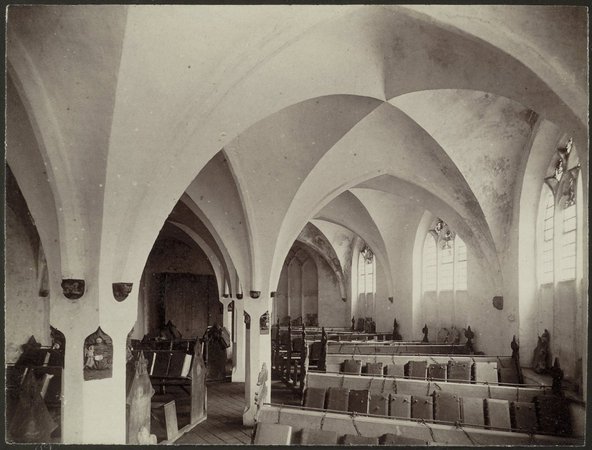
Librije Zutphen: The Medieval Library. Image credit: Rijksdienst voor het Cultureel Erfgoed.
The problem for medievalists
If those who might come to medieval Latin via classics are put off by the prejudice that has attached to it since at least the Renaissance and consider the subject matter alien, what about those who might find interest in any aspect of the hugely various subject matter in medieval Latin? How are students of medieval life, history, literature, philosophy, culture, etc. to engage with the material? Only a fraction of these writings and documents have been translated into modern languages.
A key problem appears to be a practical one: if students can find training in Latin at all, it is likely to be in the literary language of the Roman era, a language that is certainly not always identical with its later medieval variety (though of course there are significant overlaps).
While we can find medieval Latin that fully respects the strictures of the classical variety, not all does. In vocabulary, grammar, and spelling, many medieval texts show significant differences from the classical form. This is particularly true in certain kinds of material of special interest to medievalists, such as accounts, letters, or other records, or scientific and philosophical writings. Developments in society, technology, and so on naturally led to the coining of new vocabulary: the Dictionary of Medieval Latin from British Sources, for instance, records thousands of words and usages in the language that were new in the period, often borrowed from the users’ native languages (above all, English and French), such as huswiva (‘housewife’), essewera (‘sewer’), but sometimes derived from existing Latin words, such as exaquare (‘to drain or lead water from’).
In grammar, the constructions in which some forms of words were used, such as the cases of nouns and moods of verbs, were different. And spelling was clearly affected by the contemporary pronunciation, changing as it developed, with borrowed words especially susceptible to variability in their spelling because their source language had no fixed written form and dialect variation. To give just one example, several dozen spellings are attested for the medieval Latin word maeremium (‘timber’, a borrowing from French).
These usages are of course unlikely to feature in typical training in Roman era Latin. To the medievalist, then, Latin may seem to present itself as a particularly troublesome barrier to the medieval period.
However, just as the classicist needs to be aware of the medieval, so too the medievalist does need that awareness of the classical. As we argued above, many medieval Latin users were impressively familiar with the classical texts as readers if not writers or copyists. Those who recorded business accounts or who wrote about optics or theology would nevertheless still have encountered Latin from earlier eras during their education. While much of this must have been the language of the Christian church found in liturgy and the Bible (both of which were in turn affected by the earlier classical language), their own use of Latin was both directly and indirectly influenced by the prestigious classical Latin and works written in it, either when they tried to emulate it or because they had an awareness of themselves using the language differently. Thus, their writings require the medievalist to keep in mind the writers’ full familiarity with Latin – not only what we see in their writing but also their experience in reading, speaking, and hearing.
The Renaissance, the Reformation and the end of Latin
In Britain, the end of Latin that can be thought of as medieval came with the Renaissance and Reformation. The dramatic shifts in cultural, aesthetic, and theological perspective that these movements brought about meant that the use of Latin was very much reduced by the end of the Tudor monarchy. The Latin that remained (e.g. for international scientific communication) was strongly in line with the classical Roman language, sowing the seeds of the modern-day association of Latin almost exclusively with the Romans.
Dr Richard Ashdowne teaches Classics and Linguistics at University College, Oxford and is the editor of the Dictionary of Medieval Latin from British Sources. Dr Carolinne White was an assistant editor of Dictionary of Medieval Latin from British Sources. They jointly edited Latin in Medieval Britain (Proceedings of the British Academy 206).


